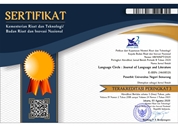Syntactic Analysis of Chinese Imperative Function in "The Captain" Movie
(1) Universitas Sumatera Utara
(2) Universitas Sumatera Utara
(3) Universitas Sumatera Utara
Abstract
This article analyzes the function of imperative sentences contained in the "The Captain" movie by applying Zhang's theory of imperative sentence function. The research method used is descriptive qualitative research methods. The data source in this research is the 2019 China movie“The Captain†(ä¸å›½æœºé•¿ ZhÅngguó JÄ«zhÇŽng). The data are imperative words and sentences in the movie. The data collection technique used was the observation and note technique according to Mahsun, then used the data analysis technique of Miles and Huberman. Researchers found 281 imperative sentences in "The Captain" movie and analyze the imperative function. The most widely used imperative function is the commanding function, which is 80 sentences. Meanwhile, the least function used was a threatening function with only 1 sentence. The commanding function is more dominant than other functions and is found in the conversations between officers to passengers, flight attendants to passengers, communication between officers and others. The commanding function is also mostly found in the officer’s conversations, especially when they were facing an emergency situation. Meanwhile, the words used by the officers, flight attendants, and the captain were showing respect and courtesy. So that the threatening function was less found in this movie. There are no requesting and begging functions because this movie tells about the incident of the Sichuan flight 8633, including the service of the aircraft officers and the confidence of the officers in facing the emergency situation at that time.
Keywords
Full Text:
PDFRefbacks
- There are currently no refbacks.

This work is licensed under a Creative Commons Attribution 4.0 International License

